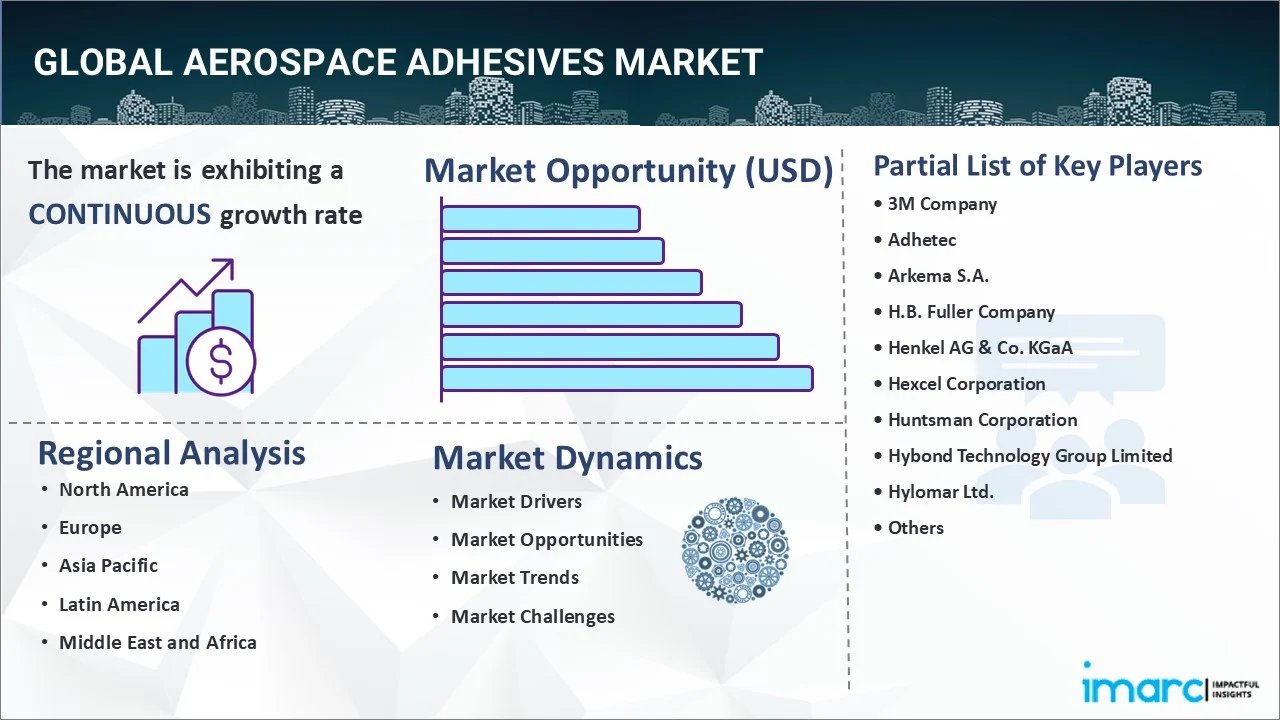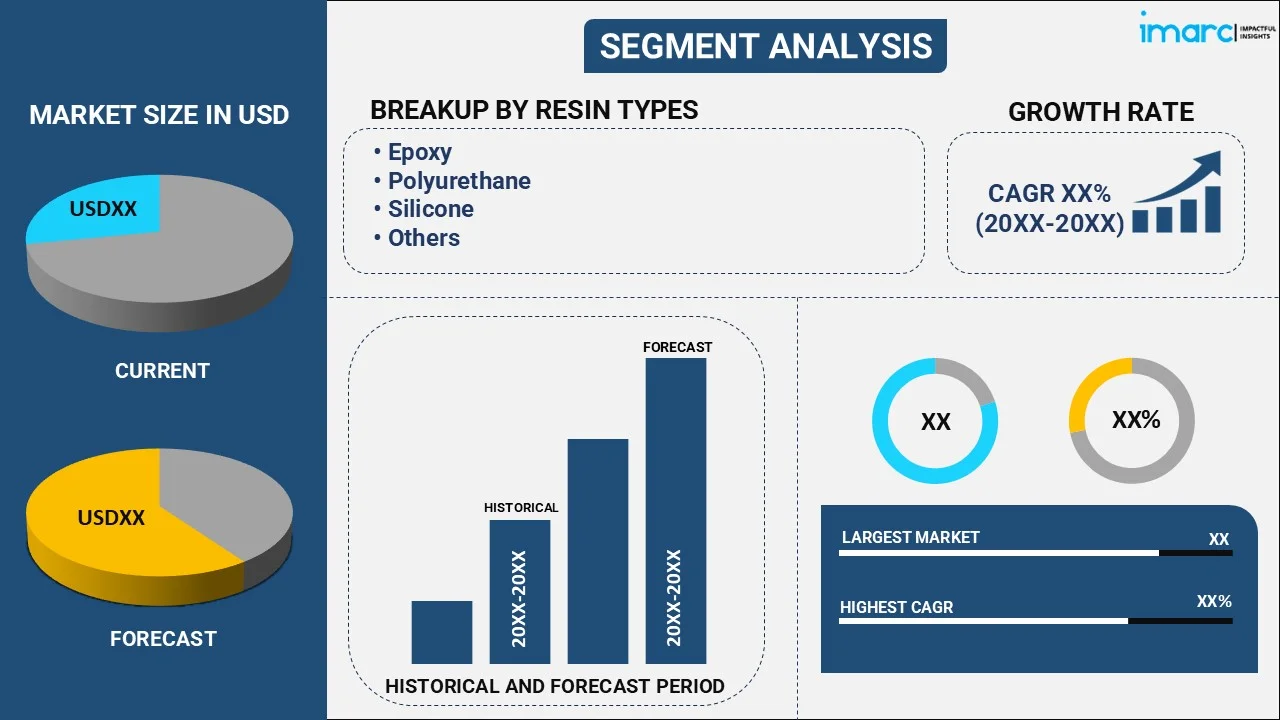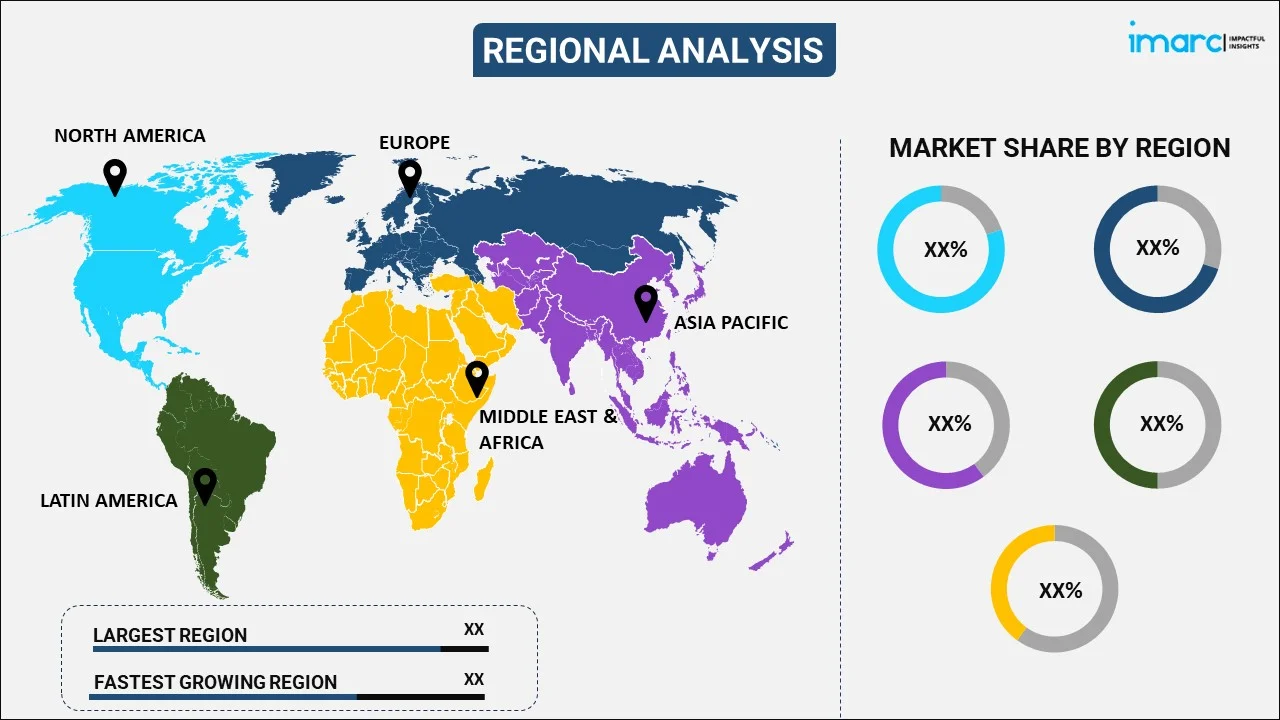
Aerospace Adhesives Market Report by Resin Type (Epoxy, Polyurethane, Silicone, and Others), Technology (Waterborne, Solvent-Borne, Reactive), Function Type (Structural, Non-Structural), End Use (Original Equipment Manufacturer (OEM), Maintenance Repair and Operations (MRO)), and Region 2025-2033
Global Aerospace Adhesives Market:
The global aerospace adhesives market size reached USD 721.0 Million in 2024. Looking forward, the market is expected to reach USD 1,073.0 Million by 2033, exhibiting a growth rate (CAGR) of 4.29% during 2025-2033. The increasing demand for lightweight structures, ongoing technological advancements, development of high-performance adhesives, and the escalating demand for commercial aircraft, are primarily driving the market growth.
|
Report Attribute
|
Key Statistics
|
|---|---|
|
Base Year
|
2024 |
|
Forecast Years
|
2025-2033 |
|
Historical Years
|
2019-2024
|
| Market Size in 2024 | USD 721.0 Million |
| Market Forecast in 2033 | USD 1,073.0 Million |
| Market Growth Rate 2025-2033 | 4.29% |
Aerospace Adhesives Market Analysis:
- Major Market Drivers: The increasing air passenger traffic worldwide, along with the rising focus on improving the performance of aircraft structures to ensure safe and reliable air travel, represents key factors bolstering the market growth.
- Key Market Trends: The increasing government spending on the modernization of military aircraft coupled with the development of innovative grades of aerospace by manufacturers are expected to escalate the market demand. Moreover, aerospace adhesives are widely preferred over mechanical fasteners like bolts or screws to maintain structural integrity and weight factors and achieve certain aesthetic design or functional benefits, further propelling the industry's growth.
- Competitive Landscape: Some of the prominent companies in the market include 3M Company, Adhetec, Arkema S.A., H.B. Fuller Company, Henkel AG & Co. KGaA, Hexcel Corporation, Huntsman Corporation, Hybond Technology Group Limited, Hylomar Ltd., Illinois Tool Works Inc, L&L Products, Permabond LLC, and PPG Industries Inc., among many others.
- Geographical Trends: North America is a significant market for aerospace adhesives due to the presence of major aircraft manufacturers, such as Boeing. Moreover, European regulations on emissions and sustainability drive the adoption of eco-friendly adhesives with low VOC (Volatile Organic Compounds) emissions and recyclable properties. Furthermore, the Asia-Pacific region is witnessing rapid growth in aerospace manufacturing, driven by increasing demand for air travel, economic growth, and expanding airline fleets.
- Challenges and Opportunities: Stringent regulatory requirements in the aerospace industry and the rising pressure to reduce production costs are hampering the market growth. However, continuous advancements in adhesive technologies, such as nanotechnology, hybrid adhesives, and smart adhesives, offer opportunities to develop adhesives that meet evolving aerospace requirements for lightweight structures, noise reduction, and fuel efficiency.

Aerospace Adhesives Market Trends:
Adoption of Lightweight Materials
Aerospace manufacturers are increasingly adopting lightweight materials, such as carbon fiber composites, aluminum-lithium alloys, and titanium alloys to improve fuel efficiency and reduce emissions. For instance, in February 2024, A*STAR Advanced Remanufacturing & Technology Center announced the launch of a premium carbon fiber material that is derived from retired aircraft to adhere to aviation requirements. Adhesives play a critical role in bonding these materials, as traditional mechanical fastening methods may not be suitable for joining lightweight structures. The shift towards lightweight materials is a significant driver for the aerospace adhesives market. For instance, according to IMARC, the global lightweight materials market size reached US$ 208.2 Billion in 2023. Looking forward, IMARC Group expects the market to reach US$ 380.0 Billion by 2032, exhibiting a growth rate (CAGR) of 6.8% during 2024-2032. These factors are further propelling the aerospace adhesives market demand.
Growing Air Passenger Traffic
The global increase in air passenger traffic is driving demand for new aircraft deliveries and fleet expansion. For instance, according to rating agency ICRA, domestic air passenger traffic rose 6.3% in June 2024 compared to the same month the previous year and 10.4% from pre-pandemic levels. As airlines seek to modernize their fleets with fuel-efficient aircraft, there is a corresponding demand for advanced adhesives that enable lighter and more efficient aircraft designs. This growth in air travel contributes directly to the expansion of the aerospace adhesives market. These factors are further contributing to the aerospace adhesives market share.
Technological Advancements in Adhesive Materials
Continuous innovation in adhesive formulations, including epoxy, polyurethane, and silicone-based adhesives, enhances their performance characteristics, such as temperature resistance, durability, and chemical compatibility. For instance, in May 2024, Syensqo unveiled AeroPaste 1003, a new grade of its epoxy-based structural adhesives. These aerospace adhesives increase part assembly efficiency and are suitable for autoclaves. Moreover, it has high-temperature strength performance. Apart from this, advancements in nanotechnology and hybrid adhesives further expand the application capabilities of aerospace adhesives, catering to diverse aerospace requirements. These factors are further bolstering the aerospace adhesives market revenue.
Global Aerospace Adhesives Industry Segmentation:
IMARC Group provides an analysis of the key trends in each segment of the global aerospace adhesives market report, along with forecasts at the global, regional and country levels from 2025-2033. Our report has categorized the market based on resin type, technology, function type and end use.
Breakup by Resin Type:

- Epoxy
- Polyurethane
- Silicone
- Others
The report has provided a detailed breakup and analysis of the aerospace adhesives market based on the resin type. This includes epoxy, polyurethane, silicone, and others.
According to the aerospace adhesives market outlook, epoxy adhesives are known for their excellent bonding strength and durability, making them suitable for structural applications in aerospace manufacturing. They provide strong adhesion to various substrates including metals, composites, and plastics. While polyurethane adhesives offer flexibility and impact resistance, making them suitable for bonding dissimilar materials and components that experience vibration and stress during aircraft operations. Moreover, silicone adhesives exhibit exceptional resistance to high temperatures and thermal cycling, making them suitable for aerospace applications where components experience extreme heat variations.
Breakup by Technology:
- Waterborne
- Solvent-Borne
- Reactive
A detailed breakup and analysis of the aerospace adhesives market based on the technology has also been provided in the aerospace adhesives market report. This includes waterborne, solvent-borne, and reactive.
Waterborne adhesives are favored for their low VOC (Volatile Organic Compound) content and reduced environmental impact compared to other adhesives. They align with industry trends towards sustainability and regulatory compliance. While solvent-borne adhesives are known for their strong bonding capabilities and versatility across various substrates. They provide excellent adhesion strength and durability, making them suitable for structural bonding in aerospace applications. Moreover, reactive adhesives, such as epoxy adhesives, cure through a chemical reaction to form strong and durable bonds. They are preferred for structural bonding applications in aerospace where high strength and reliability are paramount.
Breakup by Function Type:
- Structural
- Non-Structural
The report has provided a detailed breakup and analysis of the aerospace adhesives market based on the function type. This includes structural and non-structural.
According to the aerospace adhesives market overview, structural adhesives are designed to bear mechanical loads and provide structural integrity to critical joints and components in aircraft construction. While non-structural adhesives are primarily used for attaching non-critical components and assembling interior fittings within the aircraft.
Breakup by End Use:
- Original Equipment Manufacturer (OEM)
- Maintenance Repair and Operations (MRO)
A detailed breakup and analysis of the aerospace adhesives market based on the end use has also been provided in the report. This includes original equipment manufacturer (OEM), and maintenance repair and operations (MRO).
OEM applications involve the use of adhesives during the initial production and assembly of new aircraft. Adhesives are critical in bonding primary structures, such as wings, fuselage sections, tail assemblies, and other critical components during aircraft assembly. While MRO involves the repair, upkeep, and servicing of existing aircraft to ensure continued airworthiness and operational reliability. Adhesives are used in MRO for structural repairs, bonding of components, and replacing damaged or worn-out parts.
Breakup by Region:

- North America
- United States
- Canada
- Asia-Pacific
- China
- Japan
- India
- South Korea
- Australia
- Indonesia
- Others
- Europe
- Germany
- France
- United Kingdom
- Italy
- Spain
- Russia
- Others
- Latin America
- Brazil
- Mexico
- Others
- Middle East and Africa
The report has also provided a comprehensive analysis of all the major regional markets, which include North America (the United States and Canada); Asia Pacific (China, Japan, India, South Korea, Australia, Indonesia, and others); Europe (Germany, France, the United Kingdom, Italy, Spain, Russia, and others); Latin America (Brazil, Mexico, and others); and the Middle East and Africa.
According to the aerospace adhesives market statistics, North America holds a significant share in the global aerospace adhesives market, driven by the presence of major aerospace OEMs, such as Boeing, and a robust MRO industry. Moreover, Europe also hosts major aerospace OEMs, such as Airbus, leading to a substantial demand for aerospace adhesives for both commercial and defense applications. Furthermore, Asia-Pacific is also witnessing rapid growth in aerospace manufacturing and MRO capabilities, supported by increasing air travel demand and economic development, further driving the demand for such adhesives.
Competitive Landscape:
The report has also provided a comprehensive analysis of the competitive landscape in the global aerospace adhesives market. Competitive analysis such as market structure, market share by key players, player positioning, top winning strategies, competitive dashboard, and company evaluation quadrant has been covered in the report. Also, detailed profiles of all major companies have been provided. Some of the companies covered in the market include:
- 3M Company
- Adhetec
- Arkema S.A.
- H.B. Fuller Company
- Henkel AG & Co. KGaA
- Hexcel Corporation
- Huntsman Corporation
- Hybond Technology Group Limited
- Hylomar Ltd.
- Illinois Tool Works Inc
- L&L Products
- Permabond LLC
- PPG Industries Inc.
(Please note that this is only a partial list of the key players, and the complete list is provided in the report.)
Aerospace Adhesives Market Recent Developments:
- May 2024: Syensqo unveiled AeroPaste 1003, a new grade of its epoxy-based structural aerospace adhesives.
- May 2024: MIT engineers created a nano-stitching approach to improve and protect airplanes.
- August 2023: Park Aircraft Corp. introduced the new Aeroadhere FAE-350-1 Structural Film Adhesive Product for bonding aircraft primary and secondary structures.
Aerospace Adhesives Market Report Scope:
| Report Features | Details |
|---|---|
| Base Year of the Analysis | 2024 |
| Historical Period | 2019-2024 |
| Forecast Period | 2025-2033 |
| Units | Million USD |
| Scope of the Report | Exploration of Historical Trends and Market Outlook, Industry Catalysts and Challenges, Segment-Wise Historical and Predictive Market Assessment:
|
| Resin Types Covered | Epoxy, Polyurethane, Silicone, Others |
| Technologies Covered | Waterborne, Solvent-Borne, Reactive |
| Function Types Covered | Structural, Non-Structural |
| End Uses Covered | Original Equipment Manufacturer (OEM), Maintenance Repair and Operations (MRO) |
| Regions Covered | Asia Pacific, Europe, North America, Latin America, Middle East and Africa |
| Countries Covered | United States, Canada, Germany, France, United Kingdom, Italy, Spain, Russia, China, Japan, India, South Korea, Australia, Indonesia, Brazil, Mexico |
| Companies Covered | 3M Company, Adhetec, Arkema S.A., H.B. Fuller Company, Henkel AG & Co. KGaA, Hexcel Corporation, Huntsman Corporation, Hybond Technology Group Limited, Hylomar Ltd., Illinois Tool Works Inc, L&L Products, Permabond LLC, PPG Industries Inc., etc. |
| Customization Scope | 10% Free Customization |
| Post-Sale Analyst Support | 10-12 Weeks |
| Delivery Format | PDF and Excel through Email (We can also provide the editable version of the report in PPT/Word format on special request) |
Key Benefits for Stakeholders:
- IMARC's report offers a comprehensive quantitative analysis of various market segments, historical and current market trends, market forecasts, and dynamics of the aerospace adhesives market from 2019-2033.
- The research study provides the latest information on the market drivers, challenges, and opportunities in the global aerospace adhesives market.
- The study maps the leading, as well as the fastest-growing, regional markets. It further enables stakeholders to identify the key country-level markets within each region.
- Porter's five forces analysis assists stakeholders in assessing the impact of new entrants, competitive rivalry, supplier power, buyer power, and the threat of substitution. It helps stakeholders to analyze the level of competition within the aerospace adhesives industry and its attractiveness.
- The competitive landscape allows stakeholders to understand their competitive environment and provides insight into the current positions of key players in the market.
Key Questions Answered in This Report
The aerospace adhesives market was valued at USD 721.0 Million in 2024.
The aerospace adhesives market is projected to exhibit a CAGR of 4.29% during 2025-2033.
The aerospace adhesives market is driven by advancements in lightweight, high strength bonding technologies, increasing aircraft production, and the demand for fuel-efficient, durable materials. Additionally, the need for improved performance in harsh environmental conditions, along with growing regulations promoting sustainability, boosts the adoption of specialized adhesives in the aerospace industry.
North America currently dominates the market driven by increasing demand for lightweight, high-performance materials in aircraft manufacturing.
Some of the major players in the aerospace adhesives market include 3M Company, Adhetec, Arkema S.A., H.B. Fuller Company, Henkel AG & Co. KGaA, Hexcel Corporation, Huntsman Corporation, Hybond Technology Group Limited, Hylomar Ltd., Illinois Tool Works Inc, L&L Products, Permabond LLC, PPG Industries Inc., etc.
Need more help?
- Speak to our experienced analysts for insights on the current market scenarios.
- Include additional segments and countries to customize the report as per your requirement.
- Gain an unparalleled competitive advantage in your domain by understanding how to utilize the report and positively impacting your operations and revenue.
- For further assistance, please connect with our analysts.
 Inquire Before Buying
Inquire Before Buying
 Speak to an Analyst
Speak to an Analyst
 Request Brochure
Request Brochure
 Request Customization
Request Customization




.webp)




.webp)












